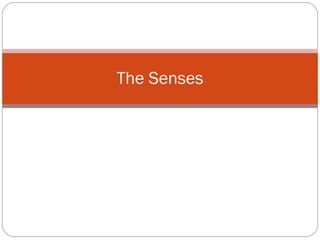
Sensory system
- 1. The Senses
- 8. Light Pressure, Temperature Sound Chemicals Chemicals
- 9. The Eye Parts Functions Aqueous humor clear watery fluid found in the anterior chamber of the eye; maintains pressure and nourishes the cornea and lens Blind spot small area of the retina where the optic nerve leaves the eye: any image falling here will not be seen Ciliary muscles involuntary muscles that change the lens shape to allow focusing images of objects at different distances Cornea transparent tissue covering the front of the eye: does not have blood vessels; does have nerves
- 10. Parts Functions Cones photoreceptors responsive to color and in bright conditions; used for fine detail Rods photoreceptors responsive in low light conditions; not useful for fine detail Iris circular band of muscles that controls the size of the pupil. The pigmentation of the iris gives "color" to the eye. Blue eyes have the least amount of pigment; brown eyes have the most Lens transparent tissue that bends light passing through the eye: to focus light, the lens can change shape
- 11. Parts Functions Optic nerve bundle of over one million axons from ganglion cells that carry visual signals from the eye to the brain Pupil hole in the center of the eye where light passes through Retina layer of tissue on the back portion of the eye that contains cells responsive to light (photoreceptors) Sclera tough, white outer covering of the eyeball; extraocular muscles attach here to move the eye
- 17. Outer Ear The outer ear or external ear is a visible portion of the ear, which serves as a protective organ for the eardrum. It collects and guides the sound waves into the middle ear. Part Function Ear Flap (Pinna) The sound waves enter the ear via the ear flap. Ear Canal (Meatus) The ear canal is about 2 cm in length. It amplifies the sound waves and channelizes them to the middle ear. Sweat glands are present in this canal, which secretes earwax.
- 18. Middle Ear Located between the outer ear and the inner ear, it perceives the sound waves from the outer ear in the form of pressure waves. The middle ear is an air-filled cavity. Part Function Eardrum The eardrum, also known as tympanic membrane is a thin membrane that acts as a partition between the outer ear and the middle ear. It vibrates as soon as it receives the sound waves and transforms the sound energy into the mechanical energy. Hammer (Malleus) It is a tiny bone, located next to the eardrum. Since it lies adjacent to the eardrum, the vibrations from the eardrum cause the hammer to vibrate. Anvil (Incus) Anvil is another tiny bone next to hammer; it vibrates in response to the vibration of hammer. Stirrup (Stapes) Similar to hammer and anvil, stirrup is a tiny bone in the middle ear; eventually, it also vibrates and passes the compressional waves to the inner ear.
- 19. Inner Ear (Labyrinth): It is the innermost portion of the ear. It is filled with a water-like substance and comprises both hearing and balancing organs. Part Function Cochlea The cochlea or the spiral tube is a rolled structure that can stretch to about 3 cm; the membrane lining of cochlea consists of numerous nerve cells. The hair-like nerve cells respond differently to various frequencies of vibrations, which ultimately lead to generation of electrical impulses. Semicircular Canals These are fluid-filled loops, attached to the cochlea and helps in maintaining the balance. Auditory Nerve The electrical impulses, generated by the nerve cells, are then passed to the brain.
